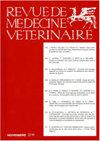Capacidad predadora in vitro de hongos nematófagos nativos de Cundinamarca sobre nematodos gastrointestinales de bovinos
Q2 Veterinary
引用次数: 3
Abstract
Dependence and indiscriminate use of chemical anthelmintics as the sole method for controlling gastrointestinal nematodes (GIN) of cattle causes problems in the environment, public health, and the productivity of cattle. It is important to develop non-chemical control strategies. Nematophagous fungi can be a viable and promising alternative for the control of these endoparasites. This study aimed to isolate, identify and evaluate in vitro the potential of nematophagous fungi from Cundinamarca on L3 larvae of gastrointestinal nematodes of cattle. 60 soil samples from cattle ranches were sown in Petri boxes containing agar-water for trapping fungi, and three strains of the fungus Arthrobotrys oligospora (L1, XVIII, and XXI) and one of Arthrobotrys musiformis (XXIV) were identified by morphometric keys. 1 x 10 6 conidia or chlamydospores of each fungi were used, which faced 100 nematode larvae. Isolate XXIV ( A. musiformis ) showed greater predatory capacity (96.8%) than isolates ( A. oligospora ) XVIII, L1, and XXI (69.68, 71.1, and 87.62%, respectively). There were no statistically significant differences (p > 0.05) among the strains with more predatory capacity. This is the first record of in vitro identification and evaluation of the predatory capacity of A. oligospora and A. musiformis , native fungi from Cundinamarca. The results suggest that these fungi could be used as biocontrol agents of nematodes in cattle.Cundinamarca本地食线虫真菌对牛胃肠道线虫的体外捕食能力
依赖和滥用化学驱虫剂作为控制牛胃肠道线虫(GIN)的唯一方法,在环境、公共卫生和牛的生产力方面造成了问题。制定非化学防治策略非常重要。噬线虫真菌可能是控制这些内寄生虫的可行和有前途的替代方法。本研究旨在分离、鉴定和体外评价产自Cundinamarca的噬线虫真菌对牛胃肠道线虫L3幼虫的作用潜力。用琼脂水培养皿对60份牛场土壤样品进行了土壤分离,通过形态键法鉴定出3株寡孢节虫菌(L1、XVIII和XXI)和1株音乐节虫菌(XXIV)。每种真菌各取1 × 10 6个分生孢子或衣原孢子,面对线虫幼虫100只。分离物XXIV (musiformis)的捕食力(96.8%)高于分离物XVIII、L1和XXI(分别为69.68%、71.1%和87.62%)。不同捕食能力菌株间差异无统计学意义(p > 0.05)。本文首次在体外鉴定和评价了云南原生真菌A. oligospora和A. musiformis的捕食能力。结果表明,这些真菌可作为牛线虫的生物防治剂。
本文章由计算机程序翻译,如有差异,请以英文原文为准。
求助全文
约1分钟内获得全文
求助全文
来源期刊

Revue De Medecine Veterinaire
农林科学-兽医学
CiteScore
1.30
自引率
0.00%
发文量
0
审稿时长
18-36 weeks
期刊介绍:
The Revue de Médecine Vétérinaire publishes four kinds of text:
1) Scientific reviews on subjects related to veterinary and comparative medicine. Suggested length: 10 to 30 typed pages.
2) Original reports on fundamental or applied research. Suggested length: 10 to 15 typed pages.
3) Continuous education articles, that should be easily understandable by non-specialists. Suggested length: 10 to 15 typed pages.
4) Clinical reports. Suggested length: 5 to 15 typed pages.
The publication can be done in French language or English language.
For an article written in English by not english native speakers authors, the manuscript must be subjected by attesting that it was read again by an anglophone scientist or a scientific translator.
The authors must certify that the manuscript was not published or subjected for publication to another review.
The manuscript must be accompanied by a sheet signed by all the joint authors indicating their agreement for the tender of the manuscript.
The publication is free but a financial participation could be required for the photographs color. An estimate will be sent to collect the agreement of the authors.
 求助内容:
求助内容: 应助结果提醒方式:
应助结果提醒方式:


